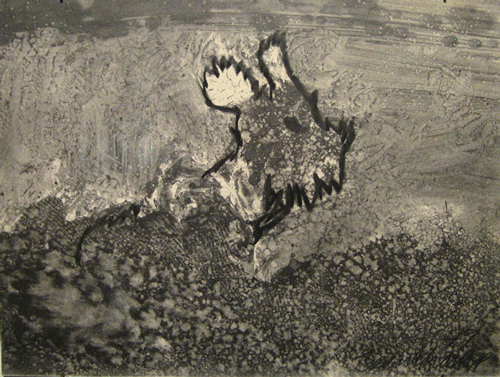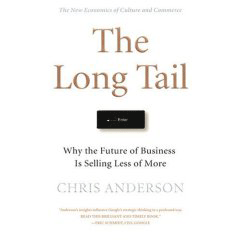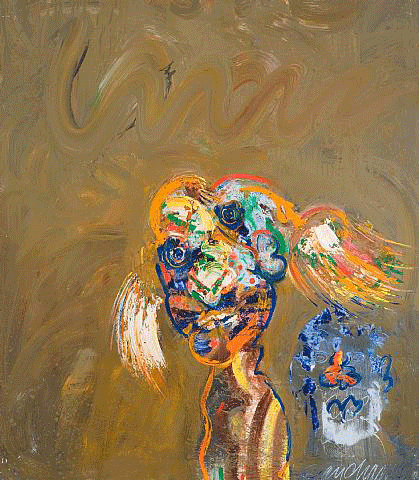November 7, 2006
Eras End and Begin Again

I've had a few thoughts that have been rattling around in my head recently, and I'm going to try to trot them out to see how they hang together. What is to come might be a bit raw... but this is a blog after all (a series of first drafts).
Aaron Parazette dropped a line to say hello and pass on some interesting reading. It was the introduction from Chris Anderson's "The Long Tail":
Hi D, back from SF--all went well, I'll fill you in when we talk (thanks for the props on the blog). Here's another essay--got it from Michelle Grabner the other day. Relevant for all us culture producers. AHere is a snip near the beginning of the introduction:
...This is the world the blockbuster built. The massive media and entertainment industries grew up over the past half century on the back of box-office rockets, gold records, and double-digit TV ratings. No surprise that hits have become the lens through which we observe our own culture. We define our age by our celebrities and mass-market products?they are the connective tissue of our common experience. The star-making system that Hollywood began eight decades ago has now spun out into every corner of commerce, from shoes to chefs. Our media is obsessed with what?s hot and what?s not. Hits, in short, rule. Yet look a little closer and you?ll see that this picture, which first emerged with the postwar broadcast era of radio and television, is now starting to tatter at the edges. Hits are starting to, gasp, rule less. Number one is still number one, but the sales that go with that are not what they once were...
And here are the concluding paragraphs:
Seen broadly, it?s clear that the story of the Long Tail is really about the economics of abundance?what happens when the bottlenecks that stand between supply and demand in our culture start to disappear and everything becomes available to everyone.After listening to the Bad at Sports PodCasts (#'s 12, 19, 32 & 39) featuring Lane Reylea and Michele Grabner (check out the link, I highly recommend listening to the podcasts), I got the impression that both of these writers for ArtForum are simultaneously insiders and outsiders in the heart of the art industry* and that they have a palpable sense of the ground shifting beneath our feet. They both indicate a striking poverty of ideas and a universal lack of a sense of direction in the art world. Finally, Grabner advised a more careful scholarship to plot our way out of our late pomo Sargasso Sea and somewhat disturbingly yet tantalizingly, Reylea outright called for violent change (although I'm sure he meant it figuratively... I guess it's easy to smash the guitar against the amp since rock and roll never really dies).
People often ask me to name some product category that does not lend itself to Long Tail economics. My usual answer is that it would be in some undifferentiated commodity, where variety is not only absent but unwanted. Like, for instance, flour, which I remembered being sold in the supermarket in a big bag labeled ?Flour.? Then I happened to step inside our local Whole Foods grocery and realized how wrong I was: Today the grocery carries more than twenty different types of flour, ranging from such basics as whole wheat and organic varieties to exotics such as amaranth and blue cornmeal. There is, amazingly enough, already a Long Tail in flour.
Our growing affluence has allowed us to shift from being bargain shoppers buying branded (or even unbranded) commodities to becoming mini-connoisseurs, flexing our taste with a thousand little indulgences that set us apart from others. We now engage in a host of new consumer behaviors that are described with intentionally oxymoronic terms: ?massclusivity,? ?slivercasting,? ?mass customization.?
They all point in the same direction: more Long Tails.
After years of emulating the blockbuster effect in the promotion of careers in the art world, there is a sense that the phenomena of the eclipse of the superstar is occuring. Vectors of art power brokers which align on selected (and admitedly talented) artists, the sold out simultaneous solo shows, the lavish coffee table catalogs, the worldwide museum tours, the pride of place in the advertizing thickened magazines, the emulation by students and piggy backing by professors that promises to transmute power into prestige... it's all so tired now. Yes, we all want this for ourselves... but do we realy believe in it anymore?
For a parallel example in entertainment, I can point to the current Borat phenomena --a classic blockbuster engine cranking up to speed... but to me it seems creaky and ultimately lackluster. There was a moment at the end of summer when you could see everyone in the entertainment industry warily jumping on the bandwagon, no one wanting to be left out. Baron Sasha Cohen is definitely talented, funny more often than not, but dazzle today does not seem to be the way it was in the recent past. Television no longer has the authority it had in the three big primetime networks. Late night network comedy is no longer a force of habit. The newsprint media is a dead man walking, the New York Times is a hollowed out zombie. No one goes to libraries anymore, encyclopedias are curious relics --when they are not doorstops. Movies are being eclipsed by video games and reflexive MySpace personal account management. The audience is no longer captive.
Hence the rapt attention towards the dynamics of our info age paradigm shift.
I've been seeing a pattern in the phantasmagoria, the sermon is appearing in the suicide (see the colophon to the left for the reference). I've been noticing that the legacy artists that younger artists around me have been looking at are not only the rediscovered underdogs (as per Anderson's thesis) but that maybe the work of these underdogs share certain formal characteristics in common.
It's time to lay out a few examples:
The hardest part of this post was to figure out what to excerpt from Chris Jager's blogpost about nearly forgotten artist Robert Beauchamp. (The bunny-like image heads this post.) So I clipped the whole thing:I just saw the Beauchamp drawing show at the SMU Pollock Gallery ? truly weird and amazing. You may be thinking, ?who?? Here is a fragment of the introduction for the show:
?The American painter Robert Beauchamp (1923-1995) was one of the earliest and most well respected figurative painters to ermerge from the New York School of the late 50?s. Arriving on the scene a few years after Jackson Pollock, Beachamp (pronounced ?Bee-Chum?) choose to use figuration as he found abstraction unable to communicate the realities of the human condition as he saw them?prefiguring in many ways the renewed interest in the figure as subject matter in the late 80?s that persists even now?Beauchamp continued to work into his last weeks, even as he battled the cancer that ended his life. He died at home in New York City at the age of seventy one.?Philip Van Keuren, the curator, told me there were literally hundreds of these drawings, just from 1979, the drawings that populate this show. The drawing materials look like heaps of graphite powder, turpentine, and charcoal sticks on paper - but no one really knows for sure. Above is a strip of drawing from his ?Unicorn? series that he made after seeing the Cloisters Unicorn tapestries at the MET. Seeing similarities and making these intellectual connections is pure pleasure - and reminds me how art is more than just pure craft. Of course, as much as I like these drawings, I find his paintings hard to like. But actually, they remind me of the new insane aesthetic of chealsea figurative painting today. But it is rare that one sees anything this truly mysterious.
I Googled therefore:

Yea, I can see what Chris means, but still, other artists are looking for something similar. For example, I was talking to Bart Exposito the other day. He was telling me of other artists that he's looking at: Pollock's neglected post drip re-figurations, other 30's era goofy surrealist figuration... a few others I cannot now recall. Then, during a visit to Bart's studio, I took a look at his copy of the Lee Bontecou MOCALA catalog co-authored by the incomparable curators Elisabeth A. Smith adn Robert Storr. I think I can see what Bart is looking for in Bontecou's ouevre.

Earlier I described a trend toward a celebration of the underdog, the overlooked artist. Now, I hope that I have trotted out enough evidence** to identify at least a formal interest in a kind of in-betweeness betwixt physical abstraction and figuration, a desire for a simultanaity of materiality and representation. It seems to be a search for the spark of the animate in the inanimate, acts of rendering that might be fully conscious -of our human history in making marks and of a respect for the limbic impulse to make them- to be simultaneously young and old, innocent and wise, a knucklehead and an impeccable professional.
Phil Wagner flagged me onto Ray Johnson's biography in the film How to Draw a Bunny" a year ago. Johnson, an artist who was one of those guys who fell by the wayside as the blockbuster engines roared past their lives. The ability to believe in yourself ...without self delusion... regardless if no one else does --that's the mark of an artist. Young artists watch this film with a grim resolve, I'm sure, like marines getting the tactical map briefing prior to D-Day. And artists definitely look to Johnson for models of commitment and for strategies for sustaining inspired creativity, Steve LaRose's postcard blog work for example.

The big question seems to be: are you still an artist when no one is looking?
***
So to wind up this meandering blogpost, I should end with the beginning of the train of thought, my reply to Aaron's email:
Aaron:It's good to hear that the show went well, muy bien. The gallery looks like a good one.
Cool excerpt. A few thoughts:
Somehow I don't think that our art world is yet exploiting the advantage of the long tail. Commerce seems to operate along the dynamics of the blockbuster era. Once we have people buying our stuff by seeing our work online, then we can say the art world is playing by the long tail rule.... but our art world seems to operate in terms of prestige: the bragging rights of collectors, the status of galleries, the ranking of artists... when will we we enjoy the spontaneous micro communities of fan-enthusiasts? But then the artworld was never a broadcast entity... it was always microcast... so maybe that answers my question.
Perhaps it's like this: our artworld grew explosively in our era ('86 - '06) and as such, it emulated mass entertainment, and maybe therefore our artworld emulated the blockbuster mentality too... but did it ever take hold? Maybe blockbuster worlds can grow a tail but you have to have a fully established blockbuster world in the first place... and even though I have said that we have a blockbuster mentality in our artworld, maybe it never has fully emerged before its eclipse? Or maybe the long tail for the art wold is there, but at this stage, it's a dotted line, a mere possibility, or yet too faint a line to see as clearly as that of music or movie industries. Or perhaps it's like this: the blockbuster model belongs to youth consumers (popular film and music) and scales of mass consumption. Once teens can desire and afford to collect art, then we can begin to grow a tail of our own.
One last minor thought: this tail is identical to the exponential curve describing technological change (Moore's Law) in our time. They call it "the Singularity".
-D
*An unfortunate word, but accurate for most people in it.
**Well, re-reading this... no, I haven't. By that paragraph, only two formal examples were offered, and a third implied by the reference to Ray Johnson. If you can trust me, there were other artist's names being dropped in conversation --now forgotten unfortunately-- that better delineated the trend I am trying to describe.
Posted by Dennis at November 7, 2006 5:03 PM
Leave a comment